Behind the Scenes - Licking Memorial Occupational Therapy
 Many patients who visit Licking Memorial Health Systems (LMHS) because of a serious illness, severe injury or chronic disease often need more than primary care. Rehabilitation therapy for a few days, weeks or even months may be necessary for a full recovery. The staff members of Licking Memorial Rehabilitation Services work in conjunction with physicians and other LMHS staff members to create a plan to offer the best possible results for recovery. The plan often involves a licensed Occupational Therapist or Certified Occupational Therapy Assistant (COTA) to assist patients in achieving independence in all facets of their lives.
Many patients who visit Licking Memorial Health Systems (LMHS) because of a serious illness, severe injury or chronic disease often need more than primary care. Rehabilitation therapy for a few days, weeks or even months may be necessary for a full recovery. The staff members of Licking Memorial Rehabilitation Services work in conjunction with physicians and other LMHS staff members to create a plan to offer the best possible results for recovery. The plan often involves a licensed Occupational Therapist or Certified Occupational Therapy Assistant (COTA) to assist patients in achieving independence in all facets of their lives.
Patients are treated with occupational therapy (OT) for a variety of injuries and diseases, including:
- Hand injuries
- Fibromyalgia
- Work-related injuries
- Developmental disabilities
- Sport-related injuries
- Burns
- Amputations
- Lymphedema
- Stroke
- Heart attack
- Repetitive stress injuries
- Epicondylitis
- Tendonitis
- Arthritis
- Multiple sclerosis
- Carpal tunnel syndrome
OT is offered in a variety of settings, including inpatient, outpatient, home care and Shepherd Hill – the Behavioral Health Department of Licking Memorial Hospital. OT specialists follow guidelines and protocols established by the American Occupational Therapy Association with the focus on improving abilities to perform the activities of daily living. After an evaluation, the therapists determine the current level of function, and work to customize processes for both home and work environments.
OT utilizes many tools and technologies to improve very specific skills needed for independence, including driving skills. For patients who may be struggling to regain confidence behind the wheel, an OT specialist can offer the use of the STISIM Drive® – a driving simulator that assists in strengthening basic driving skills including reaction time, managing pedals and steering. The video-game style program can be preset to focus on the patient’s specific needs. As the patient masters a skill, the simulator can be adjusted to offer more of a challenge. The therapist can make the changes instantly as they monitor the patient’s progress in real-time. The simulator is designed for those who already possess driving skills. It is an important tool in sharpening both motor and mental acuities needed to merge, avoid obstacles or drive in a low-light setting.
To assist patients with upper extremity function, Rehabilitation Services has a BTE™ Simulator II. The programmable machine replicates hundreds of real world job and daily living functions, including tasks at home, work or sports. The isotonic resistance level can be increased gradually and the machine can be programmed to simulate tasks with fine precision. The simulator includes dozens of attachments that can be used to recreate scenarios such as turning a key in a lock, picking up heavy objects or twisting a lid to open a jar. It also offers a wide range of motions, including pivoting, raising over the head or lowering objects. A plan can be tailor-made to assist the patient in returning to normal routines and habits.
Any type of therapy begins with a referral from a physician. An evaluation is scheduled with a complete assessment including past medical history. The team of therapists use standardized assessments to obtain reliable, accurate measurements of range of motion, pain, strength, mobility, cognitive abilities and function level. The group then uses those same measures to track improvements. During the process, the staff members get to know the patient to discover what is important to the individual, what motivates that particular person, and how to obtain the best recovery results. When a patient achieves the goals set for them, the entire team considers the recovery a success.
| Posted On : 4/7/2021 8:47:58 AM